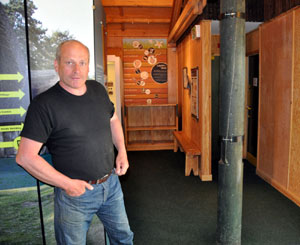
Alan Armer has been a constructor on site since 1982, working with Stanley West to develop an authentic building methodology. The reconstructed buildings have been produced through a technique called Experimental Archaeology. This involves testing out different ideas about how things were done in that time, using the same tools and techniques available to the Anglo-Saxon builders. |
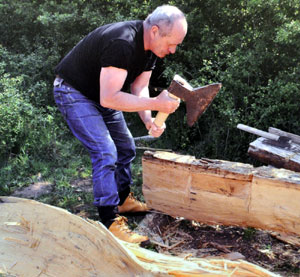
Oak trees are split with wedges and shaped into planks and beams with an axe. Most of the buildings are reconstructed on the sites of the originals, and they are based on the evidence found in the soil.
Every reconstruction is different as different techniques were tried out to find the most likely way the original buildings were constructed. |
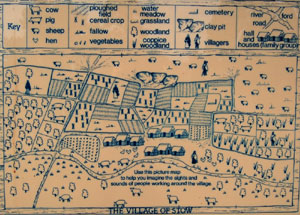
Just outside the Visitor Centre is this plan of the Village and its field layout as it might have been in its heyday in the 6th century.
The early Anglo-Saxon village (c.420-650AD) has been carefully reconstructed where it was excavated. However, we cannot reproduce the surrounding environment in which the Anglo-Saxons lived. |
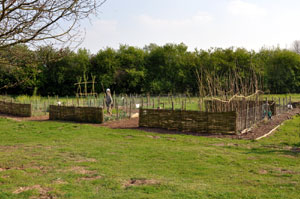
Various attempts have been made to grow crops similar to the Anglo-Saxons. This is always labour intensive and very difficult to sustain in modern conditions. Here we see the experimental vegetable garden as seen in April 2009. |
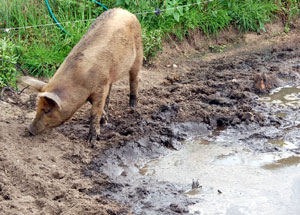
Livestock on site is considered to be an important part of a visit to the village. Requirements of animal welfare and Health and Safety of visitors make this experience slightly less authentic than it might be. |
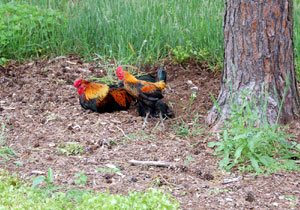
Keeping chickens on site has been thought desirable, but predation by foxes has always been a problem. |
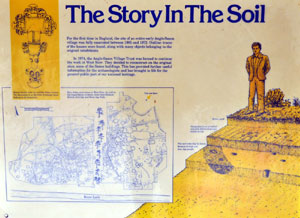
Walking past the experimental vegetable plots and the pig enclosures, you first see the information point with three panels.
This board shows a plan of the overall excavations. The line of pine trees through the plan corresponds to the trees visible behind the reconstructions. It is important to note that the original village extended well beyond these trees, and that the reconstructions represent only a small part of it. The tree belt and the enclosure around the reconstructions did not exist in Anglo-Saxon times. |
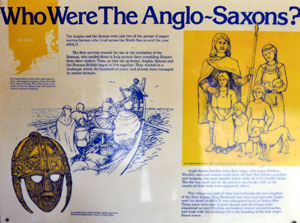
This information panel discusses the overseas origins of the Anglo-Saxons. They were made up of many separate groups, including Saxons and Friesians, but East Anglia takes its name from the Angles. |
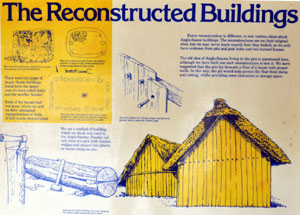
This board explains the woodworking techniques used in the reconstructions. It was deliberate policy to begin with the simplest of woodworking techniques, and then to "evolve" improvements as each building demonstrated its practical weaknesses. Policy also included reconstructions being built over the original sites of the buildings being reproduced. |
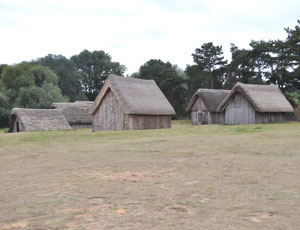
As you turn to look at the village you will see that it is on an obvious hillock or knoll. Remembering also that this higher ground extends beyond the trees, the rise in ground level explains how the village kept dry despite being next to the River Lark and its associated water meadows and marsh. This rise in the ground also protected the remains underground from the building of the 19th century sewage farm. The settling beds needed to be on level ground, and so the builders avoided the hillock. |
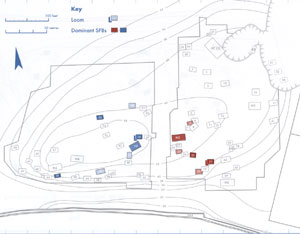
In his book "West Stow Revisited" (2001) Dr Stanley West suggested that from c440 AD to c480 AD there were these two family groups of buildings located at the site at West Stow. The dwellings marked in red were associated around hall reference H2, and are basically in the area where the reconstructed village was built in the years after 1973. The gap between the two groups represents the 19th century tree belt which now bisects the knoll on which the village stood. |
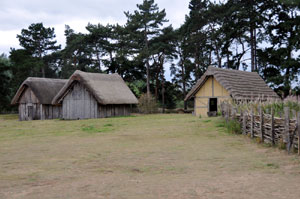
As you approach the village, the first buildings you see will be these. The Workshop is the only building with a lathe and plaster finish. Looking left you see the Living House and the Hall. However, for our virtual tour we will start with the oldest structures at the far end of the village. Please see the next page. |

